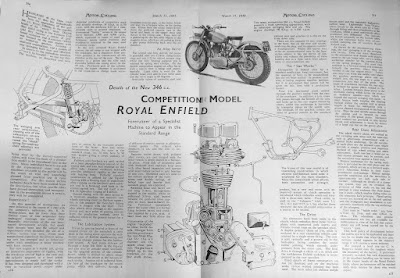 |
| Spotting this Royal Enfield was a scoop for one reporter. |
An inch or two of snow obliterated the course for the Colmore Trial of February, 1948. Marshals had to re-mark the course before the cream of trials riders could begin slipping and sliding in the first manufacturer-supported motorcycle competition of the season.
The Cotswolds were cold, and the 60-mile course icy, but there was something to warm the heart of any journalist wise enough to notice them.
"A couple of new competition models caught my eye during the Colmore Trial last Saturday, and I lost no time in booking a short flip on both of them," wrote the correspondent for The Motor Cycle on Feb. 26, 1948.
"As soon as Charlie Rogers checked in I got aboard his 346cc Royal Enfield and went dicing over the ice-bound roads on the outskirts of Shipston-on-Stour. As will be seen in the photograph on another page the new model has a beautifully neat swinging-arm type rear suspension controlled by telescopic units one each side of the wheel... The springing certainly works nicely and took the kick out of the worst rough-stuff I could find in the time available."
The reporter's "scoop" and the photo of what we would come to know as the post-war Royal Enfield Bullet are preserved in Royal Enfield's collection of clippings now in the archives of the Royal Enfield Owners Club UK. REOC archivist Bob Murdoch shared scrapbooks of the clippings with me.
I have the 1999 version of this Bullet (built in India by then) in my garage. It's remarkable to be "present" at the moment enthusiasts learned of this ground-breaking motorcycle.
Other publications were not far behind with the exciting news that this "competition model," with some features too experimental to be revealed, would be added to Royal Enfield's standard line.
 |
| This competition model would become the Royal Enfield Bullet. |
The Motor Cycle and Cycle Trader of Feb. 27, 1948 had a photo of the other side of what it called "the new Royal Enfield 350cc Sports model." Three prototypes had appeared for the Colmore, it said.
Besides the rear suspension, motor journalists noted the new motor, with its alloy head.
Their reports applauded the gearbox bolted to the rear of the motor for offering most of the advantages of unit construction without requiring splitting the cases for repairs.
Motor-Cycling's March 11, 1948 issue put it this way:
"Highlight of the Open trials season has undoubtedly been the appearance of the new 346cc Royal Enfields in the capable hands of the 'works' team. During their initial airing at the Colmore Cup trial they became a centre of pro-found attention and discussion -- which was focused on the new engine, with its bolted-up gearbox, forming a semi-unit construction, and a system of rear springing both neat and effective.
"In answer to the immediate question -- 'can it be bought?' we can say this: The machine as described and now being used by the factory-supported riders, will form the basis of a production model to be introduced later this in the year. Many individual features are still in the experimental stage and the machines available to the public will be the result of trial and knowledge gleaned from practical test in open competition. For this reason certain technical details have been omitted from the description..."
 |
| What everyone wanted to know: can I buy one? |
The magazine quoted Royal Enfield technical director R.A. Wilson-Jones to the effect that no fewer than three types of rear suspension had been tested, starting in 1939, and interrupted by the war.
(In earlier articles Wilson-Jones had hinted that rear suspension would be right for trials, and thus for everyday motorcycles. Obviously, he knew what the testing had shown.)
The Bullet, as it would be called, appeared with full road equipment in time for the Nov. 25, 1948 edition of The Motor Cycle.
 |
| The Bullet, left, in its road-worthy dress, with the brand new 500 twin. |
It would share the glory with the simultaneous introduction of the Royal Enfield 500 Twin, forerunner of exciting twin-cylinder models to come, including the Interceptor.
The vertical twin was "built primarily for fast touring" The Motor Cycle wrote. "Two entirely separate cylinder barrels are used. The new twin-cylinder engine is housed in the same type of frame as that used for the o.h.v. 350cc trials single, now known as the Bullet..."
"Before the war, the Bullet was a well-known name for sports Royal Enfields, and it is pleasant to find the name re-introduced for 1949," the magazine wrote.
It was almost too much for the press to take in, and clippings show they tended to lump the exciting new single and its new motor in with the exciting new twin, and its new motor.
Both, after all, had swinging arm suspension. The Motor Cycle marveled that the rear suspension was standard equipment, not an optional extra!
The future was here, Royal Enfield was clearly emerging from the postwar malaise. The press clippings confirm it.
 |
| Postwar 500 twin set Royal Enfield on the road to the future. |
No comments:
Post a Comment